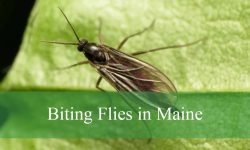Red small bugs encompass a wide range of species, each with unique behaviors and impacts on their environment. While some are garden allies, others pose threats to plants and crops.
Understanding these red small bugs is crucial for maintaining ecological balance and effective pest management.
Different Types of Red Small Bugs
Red Flour Beetles

Red Flour Beetles, small reddish-brown insects measuring 4-5 mm, are common pantry pests that infest stored grain products. These beetles target flour, nuts, seeds, and dry pet food, often entering homes through contaminated goods from markets.
Their presence often goes unnoticed in long-shelf-life products, allowing populations to thrive. Female beetles mate with multiple partners, leading to rapid reproduction. Both adult beetles and their white or yellow-white larvae infest dry foods.
Eradication requires discarding all infested items, as selective removal is ineffective due to hidden eggs and larvae. Preventive measures include regular replacement of stored dry goods to minimize infestation risks.
Red Deer Ticks

Red Deer Ticks are small, blood-feeding arachnids that pose significant health risks to humans and animals. Preferring larger mammals, these ticks are commonly found in woodland areas and dense vegetation. They attach to hosts through contact with infested foliage, causing painful bites and potentially transmitting serious diseases like Lyme disease.
Removal requires careful extraction with tweezers. Prevention strategies include avoiding dense vegetation, using insect repellents containing picaridin, and maintaining well-trimmed lawns and vegetation around homes, especially those near wooded areas.
The ticks’ preference for larger blood meals and disease-carrying capacity make them particularly dangerous, necessitating vigilance in tick-prone environments.
Red Spider Mites

Red Spider Mites, minuscule arachnids measuring around 0.5 mm, primarily feed on plant sap but can occasionally bite humans, causing pain and allergic reactions. Commonly found on apple trees and dense vegetation, these pests thrive in dry conditions, making high humidity their natural deterrent.
Prevention strategies include regular plant watering, vegetation trimming, and the spring application of insecticidal soaps. For large-scale infestations, particularly in agricultural settings, introducing predatory species like lacewings can effectively control populations.
Red Spider Mites’ rapid reproduction rate makes prevention crucial, as established infestations are challenging to eradicate. Their preference for dry environments and vulnerability to natural predators offer key insights for effective management strategies.
Boxelder Nymphs
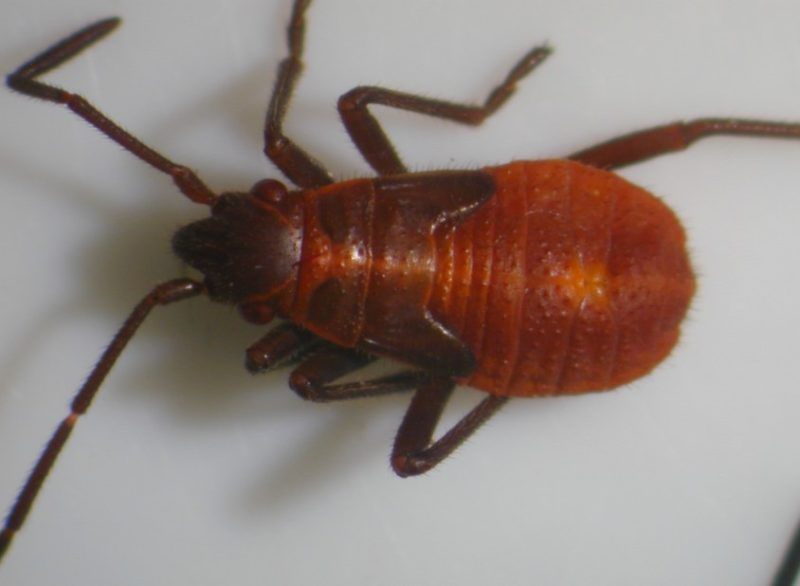
Boxelder nymphs, the immature form of Boxelder bugs, are small red and black insects that rarely bite unless handled roughly. These young bugs feed on the sap of boxelder, ash, and other trees, appearing in spring or early summer before maturing in mid- to late-summer.
While their tree damage is minimal, the main issue arises when adults seek warm shelter indoors during the fall for overwintering.
Although harmless to humans and property, their presence can be unpleasant, and they leave red stains when crushed. Removal methods include vacuuming or spraying with soapy water. Prevention focuses on sealing entry points to homes before the fall migration.
Red Ants

Red ants, particularly Red fire ants, are notorious for their painful stings and potential to cause allergic reactions. These red or red-brown insects can enter homes through small openings and are capable of stinging multiple times, injecting toxins that cause itching and, in severe cases, nausea, sweating, and fever.
Prevention methods include sealing entry points and using natural deterrents like peppermint essential oil. Eradication techniques range from pouring boiling water on ant colonies to using baking soda or commercial insecticides. For persistent problems, annual professional pest control treatments are recommended.
Spiders

Red spiders, particularly the Red House Spider, are common inhabitants of homes and man-made structures. These arachnids, measuring 5-8 mm, resemble Black Widows but are less dangerous. While they possess venom, it’s not necrotic and rarely causes significant pain.
Red House Spiders may bite, though the effects vary. To manage these spiders, regular vacuuming is effective for both removal and prevention. Closing windows at night can prevent light-attracted spiders from entering.
Unlike other pests, essential oils and vinegar are ineffective deterrents. The most reliable method for a spider-free home is manual removal, coupled with eliminating their insect prey from the premises.
Fruit Flies

Fruit flies, sometimes called Red house flies due to their large red eyes, are common household pests attracted to ripe and fermented fruits. While they don’t bite, these insects can be problematic due to their rapid reproduction and potential food contamination.
Fruit flies are easily identified by their distinctive red eyes when feeding. To control infestations, removing their primary food source, overripe fruit, is crucial. Storing fruits in the refrigerator is an effective preventive measure.
Fruit flies are not directly harmful, but they pose a health risk by potentially laying eggs on fruits. Swift action to eliminate these pests is necessary to prevent large-scale infestations in the home.
Chiggers

Chiggers, tiny arachnids belonging to the mite family, are notorious parasitic larvae that plague outdoor enthusiasts. Measuring between 0.15 and 0.30 mm, these minuscule red bugs are often undetectable to the naked eye.
Chiggers, commonly found in dense vegetation across states like Texas, quickly attach to passersby. Contrary to popular belief, they don’t burrow into the skin but use sharp mouthparts to inject digestive enzymes, liquefying skin cells for consumption. This process causes intense itching and inflammation, with symptoms often appearing hours after exposure. Multiple bites can occur before victims realize they’ve been attacked.
Prevention measures include wearing protective clothing and showering promptly after outdoor activities in chigger-prone areas. Understanding these elusive creatures is crucial for those venturing into nature, as their impact can significantly disrupt outdoor experiences.
Scarlet Lily Beetle
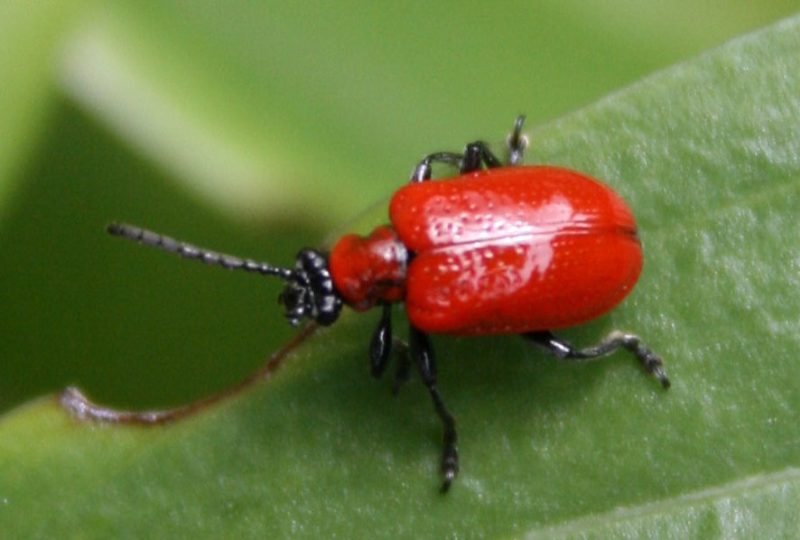
Scarlet Lily Beetles (Lilioceris lilii) are flattened, oval-shaped insects with a distinctive orange-red or red coloration. These pests primarily target lily plants and other members of the Liliaceae family, causing significant damage to garden lilies. While they don’t bite humans, their destructive nature poses a serious threat to lily cultivation.
Gardeners face a dilemma: forgo planting lilies altogether or implement effective control measures. For those unwilling to give up these decorative flowers, natural remedies offer hope.
Neem oil and essential oils, particularly peppermint, have proven successful in combating these beetles when sprayed directly on lily plants. These preventive treatments help maintain the beauty of lilies while keeping the destructive Scarlet Lily Beetles at bay.
Clover Mites

Clover mites, tiny red arachnids, are common household and outdoor pests. While they primarily feed on clovers and grass, these bugs often invade homes, attracted by humidity. Their presence indoors may indicate water leaks or excessive moisture.
Unlike some pests, clover mites don’t bite humans. However, they pose a unique challenge: when squashed, they leave stubborn red stains on surfaces. Vacuuming is the preferred removal method to avoid this messy outcome. Prevention strategies include regular lawn maintenance and managing damp conditions around the house.
Interestingly, clover mites reproduce through parthenogenesis, with females laying numerous eggs without male involvement, leading to rapid population growth.
Bed Bugs

Bed bugs, tiny nocturnal parasites, pose significant challenges in maintaining home hygiene. These reddish insects, colored by their blood meals, often go undetected due to their nighttime feeding habits. Poor sanitation and cross-infestation from other infected areas are common causes of bed bug presence.
While their bites can cause itchiness, not all are immediately noticeable, potentially delaying detection. Eradication requires thorough cleaning measures, including vacuuming and high-temperature washing of bedding.
Bed bugs are adept at hiding in small crevices during daylight, necessitating meticulous inspection. As populations grow, infestations can spread beyond beds to nearby furniture and walls, complicating elimination efforts.
Centipedes
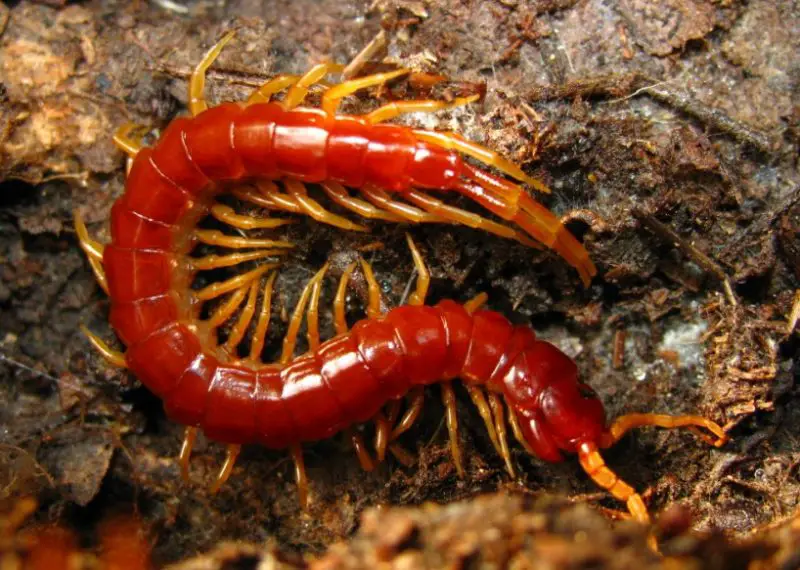
Centipedes, particularly the red variety like Scolopocryptops sexspinosus, are common household pests attracted to moist environments. These creatures, growing up to 3 inches long, can bite and should be handled cautiously. They typically seek insects and spiders for food, often entering homes through damp basements.
Controlling centipede populations involves managing humidity levels both indoors and outdoors. Trimming vegetation, using dehumidifiers, and reducing watering frequency can help eliminate their preferred habitat. These measures also deter other moisture-loving pests like roaches and earthworms, which centipedes feed on.
This species is challenging to spot due to its secretive nature; addressing environmental factors is key to effective centipede control.
Millipedes

Millipedes, often red, brown, orange, or black, are primarily outdoor creatures that feed on decaying plant matter. While generally beneficial as natural recyclers, they can accidentally enter homes. These arthropods don’t bite or sting, but they possess toxins that deter predators.
Many homeowners prefer to eliminate them when they are found indoors or on potted plants. Bug-repelling sprays are effective for killing millipedes on contact, with most curling into a defensive position when sprayed.
They don’t carry diseases, but their presence can be unsettling. Controlling millipede populations around homes typically involves the direct application of insecticides for a few seconds.
Red Springtails

Red Springtails, minuscule insects measuring around 0.2 mm, are harmless creatures that neither bite nor spread diseases. These tiny, oval-bodied bugs with short legs often enter homes through cracks or with potted plants. Thriving in moist environments, they feed on fungi and bacteria.
Controlling humidity is the most effective method for managing springtail populations. While pesticides can be used, non-toxic soil treatments are preferable. Prevention strategies include allowing soil to dry completely and using natural repellents like eucalyptus essential oil, which has insecticidal properties.
Wasps

Red wasps, particularly the Dark Paper wasp (Polistes fuscatus), are common household pests known for building large, expanding nests near or on man-made structures. These inch-long insects with dark wings are diurnal nectar feeders, constructing nests from saliva and chewed materials.
Identifying their nests is possible through the wood-like texture and nighttime buzzing. Elimination primarily involves nest removal, best done at night when wasps are inside. Smaller nests are easier to handle.
Planting flowers away from houses may help, but it’s not foolproof, as wasps can fly miles for food. Caution is crucial when dealing with these stinging insects.
Red Velvet Mites

Red Velvet Mites, small arachnids known for their biological control capabilities, exhibit an interesting life cycle. As larvae, they are parasitic, but mature into predators of various invasive bug species. These vibrant red creatures typically emerge in late summer or fall, overwintering as adults before mating in spring.
While beneficial in controlling pest populations, their presence near homes can be unwanted. Elimination methods include general insecticides, as no specific product targets Red Velvet Mites exclusively. Insecticidal soap is also effective for spot treatment.
To manage these mites, targeted application of insecticides in key areas around the house is recommended, particularly during their peak activity periods.
Snout Mites
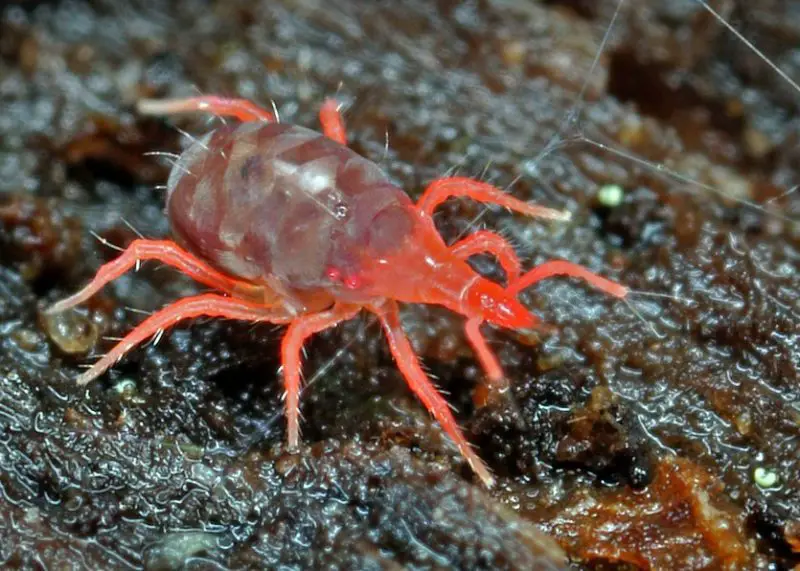
Snout mites, named for their distinctive elongated mouthparts, are orange-red to red arachnids that generally pose no direct threat to humans. These creatures primarily feed on fungi and small insects, playing a role in natural pest control. However, when their populations surge, they can become problematic.
They are typically harmless, but snout mites may trigger breathing or skin allergies in some individuals. Management strategies include biological control agents and insecticides. Proper sanitation is also crucial in controlling their numbers.
Red Aphids

Red aphids, common garden pests, are small, oval-shaped insects with short legs that exclusively feed on plant sap. They don’t bite humans due to their needle-like mouthparts designed only for piercing plants. These tiny red bugs can be devastating to gardens, potentially killing plants by excessively draining their sap. Gardeners must act swiftly to protect their flora from these voracious pests.
Effective removal methods include manual extraction, washing plants with a water hose, or applying deterrent sprays. Natural solutions like vinegar, essential oils, or soapy water can repel aphids effectively, as they strongly dislike the scent of soap.
Cockroaches

Cockroaches, particularly American cockroaches, are notorious household pests that pose significant health risks due to their ability to carry diseases and viruses. These large, brown-red insects are scavengers that thrive in homes, attracted by warmth, humidity, and available food sources. They feed on leftover food and organic material, often found in kitchens.
To prevent infestations, it’s crucial to eliminate food debris, clean up organic buildup in sinks, and seal entry points around doors and windows. Cockroaches may also seek indoor shelter during adverse weather conditions like heavy rain or sudden temperature drops.
Their preference for human dwellings and scavenging habits make them persistent and problematic pests requiring vigilant prevention and control measures.




